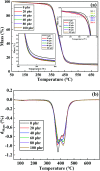Preparation and research of epoxy modified by carboxyl-terminated polybutylene adipate at room temperature
- PMID: 35919166
- PMCID: PMC9284665
- DOI: 10.1039/d2ra02915d
Preparation and research of epoxy modified by carboxyl-terminated polybutylene adipate at room temperature
Abstract
In this study, carboxyl-terminated polybutylene adipate (CTPBA) was used to modify epoxy resin, and the modified epoxy resin was cured by a room temperature rapid curing agent (T-31). The effects of CTPBA modification on bonding properties and mechanical properties of epoxy resin adhesive at room temperature were carefully studied. Epoxy-terminated prepolymer was synthesized by pre-polymerization and its structure was characterized. Compared with the addition method of direct blending, the bonding properties and mechanical properties of pre-polymerized epoxy resin adhesive were significantly better. Compared with unmodified epoxy resin, CTPBA modification significantly improved the bonding strength. Furthermore, with the increase of CTPBA content, the shear strength of the material increased first and then decreased, and reached the maximum when the addition amount was 40 phr. This shows that the tensile strength of the material decreased with the increase of CTPBA content, and the elongation at break increased with the increase of CTPBA content. Dynamic mechanical analyzer (DMA) test results showed that the addition of CTPBA reduced the glass transition temperature, but broadened the damping temperature range. TG analysis showed that the thermal stability of the modified epoxy resin was good, and compared with pure epoxy resin, the initial temperature of thermal weight loss and the maximum thermal decomposition rate decreased, but the overall thermal stability was not significantly different. In summary, CTPBA modification of epoxy resin is expected to improve the comprehensive mechanical properties at room temperature.
This journal is © The Royal Society of Chemistry.
Conflict of interest statement
There are no conflicts to declare.
Figures










Similar articles
-
Enhancement of Mechanical Properties and Bonding Properties of Flake-Zinc-Powder-Modified Epoxy Resin Composites.Polymers (Basel). 2022 Dec 5;14(23):5323. doi: 10.3390/polym14235323. Polymers (Basel). 2022. PMID: 36501717 Free PMC article.
-
Study on Epoxy Resin Toughened by Epoxidized Hydroxy-Terminated Polybutadiene.Materials (Basel). 2018 May 31;11(6):932. doi: 10.3390/ma11060932. Materials (Basel). 2018. PMID: 29857534 Free PMC article.
-
Low viscosity and low temperature curing reactive POSS/epoxy hybrid resin with enhanced toughness and comprehensive thermal performance.RSC Adv. 2024 Mar 1;14(11):7263-7275. doi: 10.1039/d3ra08390j. eCollection 2024 Feb 29. RSC Adv. 2024. PMID: 38433934 Free PMC article.
-
Study on Thermomechanical Properties and Morphology of an Epoxy Resin Thermally Conductive Adhesive under Different Curing Conditions.ACS Omega. 2024 Feb 27;9(10):11637-11645. doi: 10.1021/acsomega.3c08950. eCollection 2024 Mar 12. ACS Omega. 2024. PMID: 38497002 Free PMC article.
-
Phenylethynyl-Terminated Imide Oligomer-Based Thermoset Resins.Polymers (Basel). 2024 Oct 21;16(20):2947. doi: 10.3390/polym16202947. Polymers (Basel). 2024. PMID: 39458775 Free PMC article. Review.
Cited by
-
Enhancement of Mechanical Properties and Bonding Properties of Flake-Zinc-Powder-Modified Epoxy Resin Composites.Polymers (Basel). 2022 Dec 5;14(23):5323. doi: 10.3390/polym14235323. Polymers (Basel). 2022. PMID: 36501717 Free PMC article.
-
Synthesis and Modifying Effect of Oligoesters with Reactive Groups Based on Epoxy Aliphatic Resin and Oligoester Dicarboxylic Acids.Polymers (Basel). 2025 Feb 7;17(4):433. doi: 10.3390/polym17040433. Polymers (Basel). 2025. PMID: 40006095 Free PMC article.
-
Silicon Hybridization for the Preparation of Room-Temperature Curing and High-Temperature-Resistant Epoxy Resin.Polymers (Basel). 2024 Feb 27;16(5):634. doi: 10.3390/polym16050634. Polymers (Basel). 2024. PMID: 38475317 Free PMC article.
-
Delamination of Plasticized Devices in Dynamic Service Environments.Micromachines (Basel). 2024 Mar 11;15(3):376. doi: 10.3390/mi15030376. Micromachines (Basel). 2024. PMID: 38542623 Free PMC article. Review.
References
-
- Feng Y. Hu J. Wang F. Huang Q. Peng C. Xu Z. Mater. Res. Express. 2018;5:065321.
-
- Papanicolaou G. C. Anastasiou D. E. J. Adhes. Sci. Technol. 2021;35:1138–1153.
-
- Mohan P. Polym.-Plast. Technol. Eng. 2013;52:107–125.
LinkOut - more resources
Full Text Sources
Miscellaneous

